|
Allard
|
1906
- 1937 |
Country: |
 |
|
FOR AN all too brief period in the late forties and early fifties the name of AlIard was one of the most revered of all motor manufacturers. The company's road cars were some of the most popular among wealthy enthusiasts, especially in the USA.
The racing versions were more than competitive on the track and the company's founder, Sydney Allard, was one of Britain's leading competition drivers, winning the British Hill-climb Championship in 1949 and the Monte Carlo Rally in 1952.
With the arrival of the Jaguar XK120 and other mass produced sports cars, like the TR2 and Austin-Healey 100, demand for specialised cars like the Allard waned, and by 1956 the car was virtually out of production, although a few were assembled to special order after that date.
Sydney Herbert Allard was born in June 1910, and received his education at St Saviour's College, Ardingly, in Sussex. His father was the prosperous director of a building company, Allard and Saunders Ltd, but although his brothers followed into the building trade Sydney was already bitten by the motoring bug and, on leaving school, he entered the garage business as an apprentice. After graduating through the ranks of the motor trade he emerged as director of a small garage business in Putney.
Sydney Allard's enthusiasm for motoring also encompassed motor racing and by the age of 19 he had graduated, like so many of his contemporaries, towards Brooklands, the Mecca of British motor racing enthusiasts. His first race, a novices' three-lapper, was in a Morgan 3-wheeler on the Brooklands outer circuit. He won the race, and followed up with a repeat performance the following year in the same car.
The Morgan was later converted to four-wheeled specification and never enjoyed the same success. Allard's success was all the more remarkable because he had been accidentally shot in the left eye during his schooldays when playing with an air gun. He more or less lost the sight of this eye but managed to conceal the extent of the injury from medical inspection at race meetings.
After the Morgan he turned to the apparently more prosaic 14.9 hp Ford, into which he inserted a 24 hp engine and launched an attack on the Sporting Trials field, a peculiarly British form of motor sport which involved climbing impossibly steep, muddy, rock strewn hills. No great success ensued until, in 1935, he bought his first V8 Ford; this was an ex-Tourist Trophy car with lightweight bodywork, which proved to be very quick for its day. It won many events, both on the hills and in straight line sprints.
Allard covered the standing half-mile at the Brighton Speed Trials along the famous Madeira Drive at an average of 61.64 mph - no mean speed at that time. This Ford led to the very first Allard car, as he felt that the basic side-valve Ford V8 engine had great potential. Obtaining a crashed Ford V8 saloon, Allard ripped off the body and fitted it with a quickly hashed-up body, much of which came from a Bugatti previously owned by Earl Howe. The engine was moved back in the chassis to put more weight over the rear wheels and the car made its debut in the Gloucester Cup Trial - less than three weeks after building had begun.
Many successes followed, including a win in the 100-mile race on Southport Sands. An important modification, which was made after the car had been in use for some time, was to convert the front suspension from a rigid beam to an independent layout. Allard used the system conceived by Leslie Ballamy, who simply cut the axle in half, mounted the centres in a housing on the front chassis member and converted it to a swing axle system. The layout was also used successfully on many hundreds of Austin 7 and Ford 8 specials. It was an ideal way of giving independent suspension to cars which used a transverse leaf spring at the front and was employed on almost all subsequent Allard models.
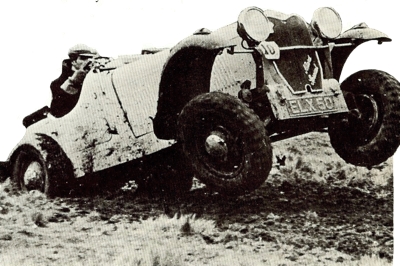 This photo shows Ken Hutchinson's 1937 Allard Special, and a reason why independent front suspension was not ideal during the 1938 Wye Cup Trial. The car was originally fitted with a 4.4 liter V12 Lincoln engine, but this was converted to a V8.
This photo shows Ken Hutchinson's 1937 Allard Special, and a reason why independent front suspension was not ideal during the 1938 Wye Cup Trial. The car was originally fitted with a 4.4 liter V12 Lincoln engine, but this was converted to a V8.
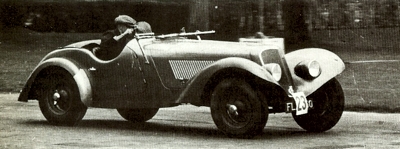 This picture shows D. G. Shilcock's 1939 Allard two-plus-one at the 1939 Poole speed trials. The plus-one referred to a third seat placed transversely behind the front ones.
This picture shows D. G. Shilcock's 1939 Allard two-plus-one at the 1939 Poole speed trials. The plus-one referred to a third seat placed transversely behind the front ones.
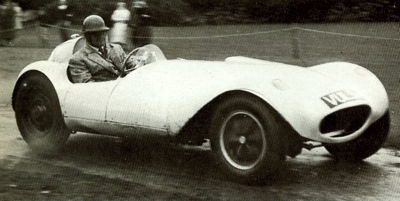 This photo shows Sydney Allard driving his Steyr-Puch special.
This photo shows Sydney Allard driving his Steyr-Puch special.
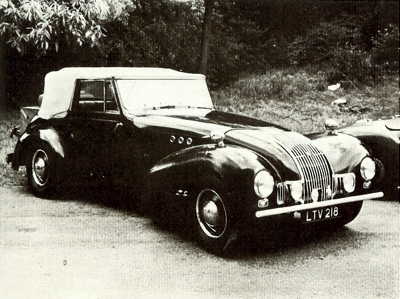 The Allard M Type was introduced in 1947, as a two-door drophead coupe version of the L tourer. Production would continue until 1950.
The Allard M Type was introduced in 1947, as a two-door drophead coupe version of the L tourer. Production would continue until 1950.
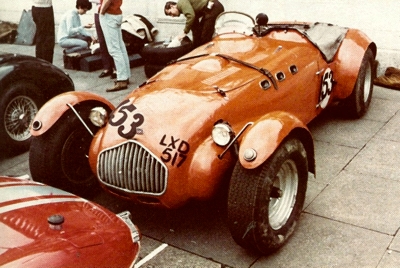 Pictured above is an 1950 Allard J2.
Pictured above is an 1950 Allard J2. |
The Tail Waggers
The initial success of the first Allard Special led to great interest from friends and fellow competitors and soon his cramped premises were busy turning out replicas. His brother Leslie bought one and fellow competitor Ken Hutchinson ordered one fitted with the American Lincoln Zephyr V12 engine. This car proved to be a very potent device. Allard and Hutchinson formed a team, known as the Tail Waggers, which collected dozens of awards in trials, hill climbs and sprints up until the outbreak of war in 1939. Allard himself gained awards in no less than 71 of the 75 events he contested in a three-year period. He even managed to break the sports car record at Prescott hill climb with the V12 car, which had primarily been built for trials work.
Repairing Military Vehicles During The War
In 1937 the first production Allards were completed, but these were really modified Fords which had been converted to two-seaters. Just as production of these cars, which sold at around £450, was getting under way in a serious form, the war broke out and Allard, who employed over 250 people by then, gave up the servicing and selling of Fords and took on government contracts in repair of military vehicles. In 1945, with peace restored, he immediately decided to start up again where he had left off six years earlier and formed the Allard Motor Company, with premises in Clapham High Street in London.
The Allard K1, L and J1
Allard still retained his directorships of other allied companies, and was joined in the Allard company by his brother Denis. Work on new car design must have progressed very rapidly in 1945 as no less than three different models were catalogued for 1946; these were the K1, the L and the J1. They were not, strictly speaking, new cars as they were still very much Ford-based and very similar in chassis layout to the pre-war cars. The basis of the cars was the British built Ford Pilot which was fitted with the 3622 cc, side-valve, V8 engine giving 85 bhp with its single Ford carburetor on a modest 6:1 compression ratio.
The engine was mated to a three-speed gearbox and the engine/gearbox unit was usually mounted well back in the box section chassis. The independent front suspension on all models was by Ballamy divided axle, and the Ford axle, mounted on leaf springs, was used at the rear. Fairly low gearing was utilised on the road cars so that acceleration was phenomenal by the standards of the day - even if top speed was not. The bodywork assisted in the acceleration, as it was made of aluminum and formed in an attractive 'wind cheating' shape.
Godfrey Imhof
The design of Allard bodywork was usually undertaken by Allard's friend Godfrey Imhof, who managed to create a flowing line on the sports tourers and saloons and a brutal ruggedness on those sports models which were intended for competition work. The three early models were very similar in basic design but differed in body style and seating accommodation. The K1, with a wheelbase of 8 feet 10 inches, was a two-seater roadster which had a slightly higher compression ratio of 7: 1 and a power output of 95 bhp, giving it a top speed in excess of 85 mph.
The L1 was a four seater tourer with a wheelbase of 9 feet 4 inches, which utilised the 85 bhp engine, and the J1 was a short-chassis two-seater with a wheelbase of 8 feet 4 inches, which turned the scales at just over the ton. This car was also made available with the 3917 cc Mercury ohv engine which gave a hefty 140 bhp. Only about a dozen J1s were built in 1946 and 1947 and most of them were converted to trials specials because of their favourable power-to-weight ratio. They acquitted themselves well in trials and a team of three, driven by Maurice Wick, Appleton and Allard himself, did extremely well until the advent of the smaller, lighter Ford 10 powered cars.
The Steyr-Puch V8
Godfrey Imhof used a Marshall supercharged 4-liter version of the Ford V8, but most of the successful cars used the Mercury unit. On the international front Imhof won the 1947 Lisbon Rally and Leonard Potter won a Coupe des Alpes in the Alpine Trial. In 1948 Allard turned his attention towards a serious attack on the British Hill-climb Championship, and for this task he built a special car using an air-cooled, Austrian built, Steyr-Puch V8 engine. This engine had been manufactured during the war for use in German staff cars but a consignment was captured when a German freighter fell into British hands.
Allard managed to buy two or three of the engines, decided that they were capable of being developed much further than their existing 85 bhp at 3500rpm, and eventually managed to obtain more than double the power of the original 3.5-liter engine. The chassis of the car was very similar to that of the J1 sports car except that a de Dion rear axle was fitted. It was immediately successful, making fastest time of the day at its first meeting at Prescott in june 1947. Allard finished third in both the 1947 and 1948 British Hill- climb Championships, then went on to win the 1949 Championship outright.
On the production side the J1 was dropped in 1947 but a two-door drophead coupe version of the L, called the M, was introduced, staying in production until 1950. The Allard alphabetical type designation may appear confusing but there was a purpose behind the lettering. The letter 1 was used for all short chassis 2-seaters, K for 2 or 3-seater tourers or roadsters, L for 4-seater tourers, M for drop head coupes and P for closed cars. When a model was superseded by a similar style of car it was given the same letter followed by a number eg 11, 12 and K1, K2, K3.
The Allard J2
There were variations on this theme because hardly two production Allards were ever alike as customers could - within reason - specify their own changes. 1949 was a momentous year for Allard because the J2 was announced. This handsome looking sports a-seater was a road car that could be raced, and demand soon began to soar as sports car enthusiasts - both in Britain and the USA - realised its potential. Mechanically it was still very similar to its Ford Pilot derived forbears, but coil springs were fitted at the front and the rigid rear axle gave way to a de Dion type inspired by that of the successful hill-climb car.
The standard engine on offer was the Mercury V8 side-valve unit which was now up to 4375 cc and 110 bhp, but a much more powerful alternative was the modified Mercury V8 which Zora Arkus-Dontov (later to design the Chevrolet Corvette) had converted to overhead valve actuation. The light alloy heads enabled the engine to develop over 140 bhp in production form,
giving the car a top speed of well over 110 mph, since this cycle-winged machine weighed little more than 18.5 cwt. Road testers spoke with awe of the fierce acceleration, negligible brakes - and a repeated tendency to ignite itself when the engine was started in the morning!
However, the J2 made the Allard name in the USA where sports car racing was beginning to find its feet. Export cars were often sent to the States without an engine or gearbox so that local drivers could fit their own units. A popular engine was the Cadillac V8 which could give 180 bhp, but other American built engines, such as the Oldsmobile Rocket and the Chrysler and Lincoln V8s, were often fitted. Competition success soon came the way of the J2 as American driver Tom Cole led several of his compatriots into a number of victories in top sports car races at tracks like Bridgehampton, Santa Anna, and Watkins Glen.
Sydney Allard entered a J2 for the 1950 Le Mans race and invited Cole to partner him. The pair ran almost faultlessly throughout the race to finish third at an average speed of 87.74 mph behind a pair of Talbots. The Le Mans car used the Cadillac V8, which unfortunately could not be sold in Britain as the post-war money crisis forced the Government to reduce imports drastically. The J2 continued successfully in America for two more seasons but the
XK120 Jaguar was now being sold in large numbers and other more specialised sports/racing cars started to take the honours in racing events.
Sydney Allard continued to take part in races and rallies however, and he returned to Le Mans in 1951 with two cars for Allard/Coles and Reece/ Hitchings, but Reece vaulted a sandbank with his car and the other car retired after putting in a lap of just over 100 mph. For 1952 another pair of cars was entered but they retired ignominiously and for 1953 it was determined that much faster cars would have to be used., The car, known as the JR, was considerably lightened and the Cadiliac engine tuned to give a claimed 300 bhp. But although Allard himself had the glory of leading the first lap of the race he was out after four laps with collapsed rear suspension, leaving his co-driver Fotheringham-Parker without a drive; the other car of Arkus-Dontov/lvlerrick also soon retired.
This was the last appearance of Allard at Le Mans, and the end of an era which was by then being dominated by the C-type Jaguar and other specialised cars. Since 1951 the J2 had been supplemented by the J2X which had a number of modifications. The engine was set forward in the chassis by 7.5 inches compared with the J2, the nose of the bodywork was extended by 6.5 inches and the front suspension used radius arms located ahead of the axle. All models with this latter modification were given the letter X after the model number.
In 1949 Allard announced the P1, the first Allard saloon, which was again basically similar to the L type tourer but with enclosed bodywork. This car formed the basis for an attack on the rallying world and in 1949 Allard himself drove a P1 to fourth place in the Monte Carlo Rally, following up the next year with eighth place. In 1952, co-driven by Guy Warburton and navigated by his long time technical assistant Tom Lush, Allard won the rally outright in a very difficult year when only 15 cars remained unpenalised on the snowbound roads.
To cash in on the rally success a new version of the P1, called the P2 Monte Carlo, was announced in 1952. This featured a de Dion rear axle and a more up-to-date space-frame-type chassis. An estate car called the Safari, using the same chassis as the P2, was also announced in 1952. These cars still had the 3622 cc Ford engine as standard, although the Monte Carlo winning car had a 4.4-liter Mercury engine. Prices had begun to escalate drastically, for whereas a 1946 L type could be bought for little more than £1000 the 1952 P2 cost well in excess of £2000. This was to cost Allard dearly, as luxury cars were hit by double taxation in Britain.
Also in 1952, in an attempt to reach a wider market, Allard announced a z-door roadster on an 8 ft wheelbase, called the Palm Beach. This came in two versions, one with the 1508 cc Ford Consul four- cylinder engine and the other with the Ford Zephyr 2622 cc six-cylinder unit. These cost less than £ 1200, but although they remained in production until 1956 demand was very small. In 1956 they were replaced by a new Palm Beach model, known as the Mk n, which had entirely new bodywork of much more modern appearance and with a choice of the new 2553 cc Ford Zephyr engine or the 3.4-liter Jaguar XK 120 engine.
The split-axle front suspension was dropped for the first time, being replaced by a torsion bar independent layout. A new X-braced chassis was used and the rigid rear axle was suspended on coil springs. The JR, which was the production version of the 1953 Le Mans cars, powered by a 250 bhp 5.4-liter Cadillac engine, was replaced in 1956 by the J2R which used the Palm Beach chassis fitted with a 270 bhp version of the Cadillac engine, although export customers were still able to fit their own engines.
By 1956 demand for specialised cars like the Allard had almost dried up. Rivalled by the more sophisticated machinery built by Jaguar; Bristol and Aston Martin, and the cheaper sports cars like the Triumph TR2, Austin-Healey 100 and MGA, the company announced that the Allard range would be available only to special order. Very few cars were built after 1956 and by 1957 the Clapham works was given over to making transmission parts for ambulances, although there was a half-hearted attempt to get into the booming three-wheeler bubble car market with a pretty machine called the Allard Clipper.
Since demand for the much improved Ford range was booming, Sydney Allard devised a range of tuning equipment for Ford cars which was marketed under the Allard name. When the
105E Ford Anglia was announced in 1959 he produced a highly tuned version with a 1500 cc engine called the Allardette. This car was popular with rally drivers and Sydney Allard, then into his 50S, drove in many rallies, often accompanied by his son Alan. The front disc brake conversion for the Anglia was a very popular Allard product.
In 1961, Sydney Allard, still enthusiastic about motor sport, visited the USA and became keen on drag racing. He immediately returned to Britain and he and his team of mechanics designed and built a dragster which was powered by a Chrysler 5.7-liter V8 giving over 450 bhp. He made a number of runs with this car and undoubtedly helped to spark off interest in drag racing in Britain. A smaller version, known as the Dragon, was produced for sale to enthusiasts; this was powered by a Ford 1.5-Iitre engine with a Shorrock supercharger.
Allard became world distributor for the Shorrock supercharger and later took over manufacture of the unit; they also sold the Wade supercharger throughout the world. Tragically, Sydney Allard died of cancer in 1966, whilst still in full control of his many business interests and still actively interested in motor sport. His son Alan took control of the business, which, because of its size, forced him to give up his own promising rally driving career.
For a time, the company marketed a wide range of racing, and road turning equipment under the Allard name. The site where the Allard cars were produced is now a housing co op and was named after the car. Allard Gardens is now a development of 26 luxury units. In the late nineties some of the Allard cars returned to the site for a re union.
